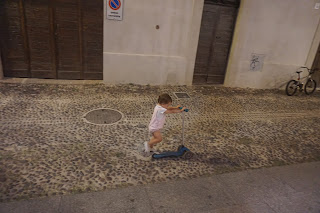
 |
| A map of where we went, a kid, and a sign for Casa Gramsci. |
We woke up in Aleghro, the full haze of the day and the
night before making its way through our minds. I dreamed of taking Dad’s
old friend Fred on a boat. He’s been gone for over a quarter of a
century. But I knew him and so did Matteo. He wore a cowboy hat when
Matteo met him, shortly before Dad took Matteo to Big Bend National Park back
in 1987. But his memory lingers this morning, as does the day before, taking a
final stroll before continuing our journey South West, through Sardignia. We’ve
love Aleghro, the medieval winding streets, the water, the piazzas, the people,
the restaurants, our boat ride. So we meander through town again, looking at
the shops and streets, picking up a few souvenirs. And make our way onto the
wild road. Driving is never easy here. The streets are a tight, congested
game of chicken as drivers vie for space. Don’t panic, notes Caroline.
Its not panic as much as fear of making a one lane road work for two cars
careening in opposite directions. But eventually we make our way onto the
windy coastal roads. They remind me of Big Sur in California, the world
whirling in front of us, coasts of the bluest water to the right, trees and
nuraghe to the left.
The House

Its hard to imagine these mounds of rocks have been there
for thousands of years, megalithic edifices developed during a Nuragic Age
somewhere between 1900 and 730 BC. But there they are, just as you find such
mounds in Ireland and Mexico. The shape of time takes countless twists and
turns, just like the road here. I can’t look too long or I’ll drive the
car off the cliffs like in the movies. But this isn’t a movie.
Careening through the hills, we made our way towards the
Marina in the Bosa Province of Oristano Sardinia , stopping for a lovely
lunch. Caroline has eggplant parm. I go swimming.
And we keep on driving, snapping shots of nuraghe when we
can. So many more, disappeared without a shot. More and more trees, more
and more coasts, a few 2000 year old mounds here or there.
“Do you want to go to Grasci’s house?” Caroline asks. He’s
been a source of ridicule for Matteo, who hates the Communists
here. We have similar ambivalent feelings. But love the
Prison Notebooks and admire his thoughts on political praxis and
education.
“Yes. Is it here?”
“Yes… Its nearby.”
A useful reminder of what happens when fascists find their
way into power and intellectuals are jailed, we made our way to Ghilarza, where
the author of The Prison Notebooks, lived.
“Its like a Camino town,” noted the little one, as we
parked by the old church.
No one was on the streets. But a few cars were
parked. Storefronts closed. We walked into the old church and then walked
toward the museum.
Closed reads the sign.
It’ll be open in ten minutes.
So we walk around a bit, exploring the town.
“Aperto?” I ask a woman toward the museum.
“In ten minutes….”
Finally, she opens the doors and showed us around the
space, full of old newspapers, photos, drafts of all the prison notebooks that
he wrote as he passed his days for a decade before he died in 1937.
“odio gli indifferenti,” declared one t shirt, referring to his
old letter, meaning, “I
hate the indifferent. I believe that life
means taking sides. One who is really alive,can be
nothing if not citizen and partisan. Indifference is lethargy:
it is parasitism, not life. ...Indifference is the
dead weight of history. plays an important role in history.
It plays a passive role, but it does play a role. It is fatality; is is
something that can not be counted on; it is something that disrupts programs,
overturns the best made plans; it is that awful something that chokes
intelligence… What happens, the evil that touches everyone, happens
because the majority relinquish their will to it, allowing the enactment of
laws that only a revolution can revoke, letting men rise to power who, later,
only a mutiny can remove.
….”
The museum displays portraits, as well as copies of the
author’s copy of the Divine Comedy. He wrote, he organized,
and he believed in our capacity to think, to believe in our own
intelligence. One of the
great joys of my life was reading the Prison Notebooks, Il
Quaderno, with Stanley Aronowitz, who wrote extensively about Gramsci in books
and essays including: “Gramsci’s Theory of Education: Schooling and Beyond”….
The last room of the museum was of the author writing in
prison.
It’s a chilling reminder that ideas are not always free.
There no happy endings here. But it less than a decade
after he perished, Gramsci’s tormentor, faced a similar fate.
In the history of movements, we fight, biker, anarchists
battle anarchists, fascists jail communists, who went onto jail countless
others after from 1945 till 1990. And the beat goes on as our president
meets with Putin. There are few happy endings here.
The House
The Antonio
Gramsci house is in the historic centre of Ghilarza, a city of about 4,500
residents in the mid-valley of the Tirso River in the Oristano Province, in the
historic and geographic sub-region of Guilcer.
Antonio Gramsci
lived here from the age of 7 to 20 years, 1898 to 1911. He was born in Ales, in
the Province of Cagliari, on 22 January 1891. After a few months, his family
moved to Sorgono and then to Ghilarza, the town his mother, Peppina Marcias,
was from. After elementary school, from 1905 to 1911, Antonio attended first
the junior secondary school at Santu Lussurgiu, then the senior secondary
school in Cagliari.
He would return
home often, from Santu Lussurgiu every Sunday and less frequently from Cagliari.
He always spent his summers at Ghilarza. At age 20, in the autumn of 1911, he
left for Turin, where he had been awarded a scholarship that allowed him to
attend the University, where he enrolled in the Faculty of Letters. He returned
again to Ghilarza during the summers of 1912 and 1913, and then for two short
visits in 1920 and 1924. From his move to Turin until the end of his life – he
died at 46 – he lived in furnished rooms, hotels, hospitals, pensions and jail
cells. This house in Ghilarza was the only real home he ever had.
The property was
then owned by Grazia Delogu, Antonio’s mother’s unmarried stepsister. During
his childhood and adolescence, ten people lived in this house: his aunt Grazia,
his father Francesco, his mother Peppina and the seven children: Gennaro,
Grazietta, Emma, Antonio, Mario, Teresina and Carlo.
The house was
built in the early years of the nineteenth century of basalt, a volcanic rock
often used in houses typical of central Sardinia. Of a simple and dignified
appearance, it consists of two storeys, with the only decorative element on the
front being the balcony and its wrought iron railings.
The interior,
which has been well preserved, has 6 bedrooms, 3 on the ground level and 3 on
the upper level, and is now used as a museum. The connection between the two
storeys is still a stairway in its initial position, and the series of rooms
remains almost entirely faithful to their original use as living quarters. In
the rear courtyard, which still has its cobblestones with flower beds marked
off with stones and tiles, there is a small building called the sa
‘omo ‘e su forru (the oven house).
Renovation
measures that were done over time did not much alter the structure of the
property, which as a whole has kept its original appearance.
The house, the
city of Ghilarza and the surrounding area were, for Antonio Gramsci, places
full of memory and affection to which he returned many times with notes of
aching homesickness. These environments were described in Letters from
Prison and Prison Notebooks or in the records by
his early biographers.
Sitting here in
Italy, where they have their own history of fascism, I see its always good to
be aware who your friends are. There are not always happy endings.

Leaving the
museum, we make our way to Agriturismo Casa Marmida outside of Guspini,
which will be our base for the next three nights. Full of sheep, pigs and farm
animals, a dog walking about, it’s provides some of the best food we’ve had
here. Our hosts are wonderful.
Spending our
nights eating on a country farm, our days boating between ancient cliffs and
grottoes, its not too bad here! We might want to stay here. We adore Sardinia!






























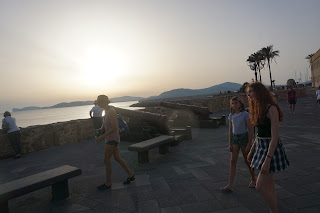




































































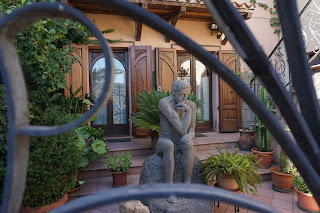
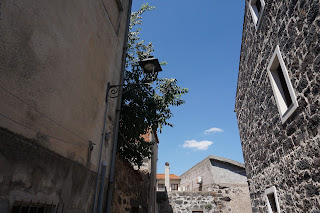











































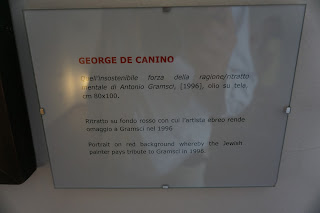


























No comments:
Post a Comment